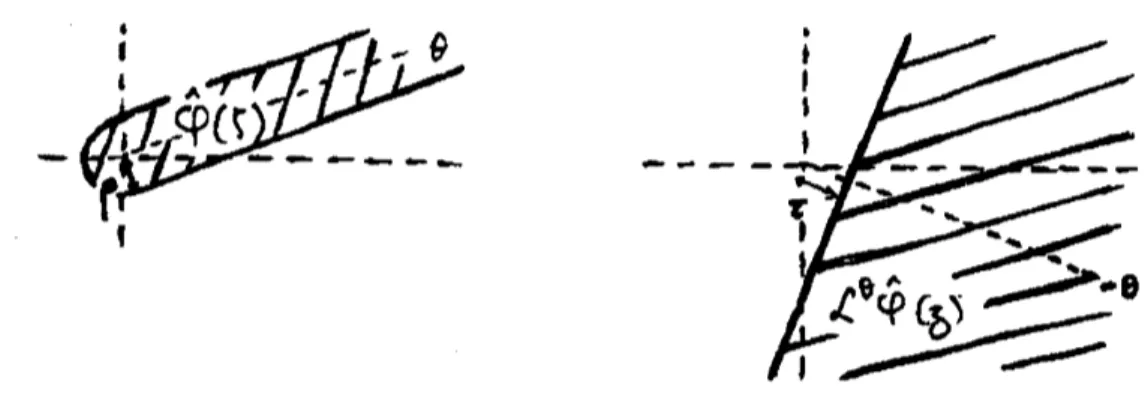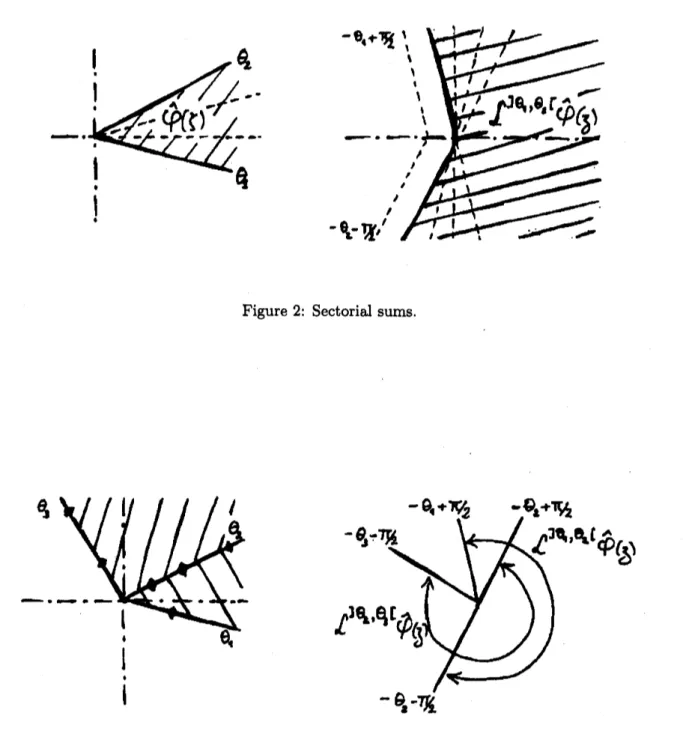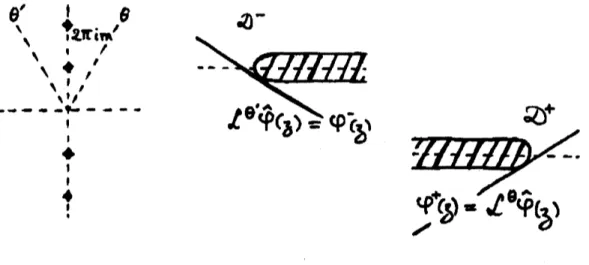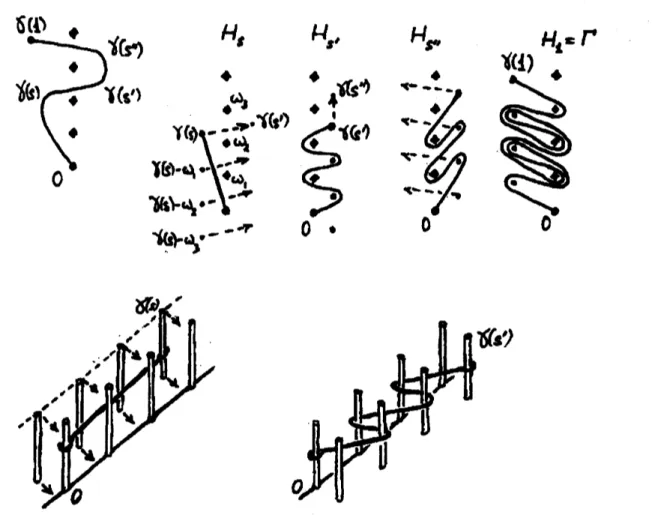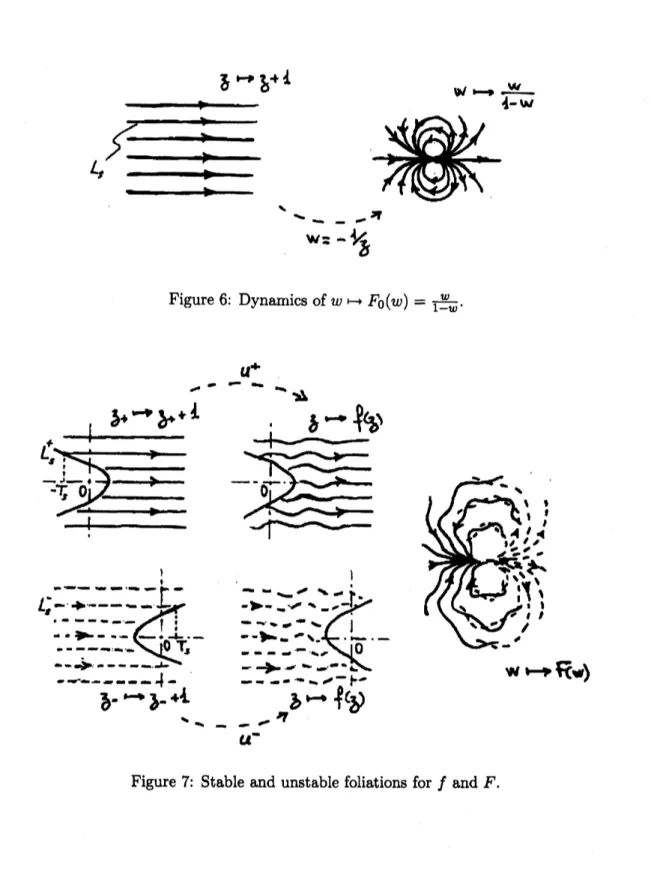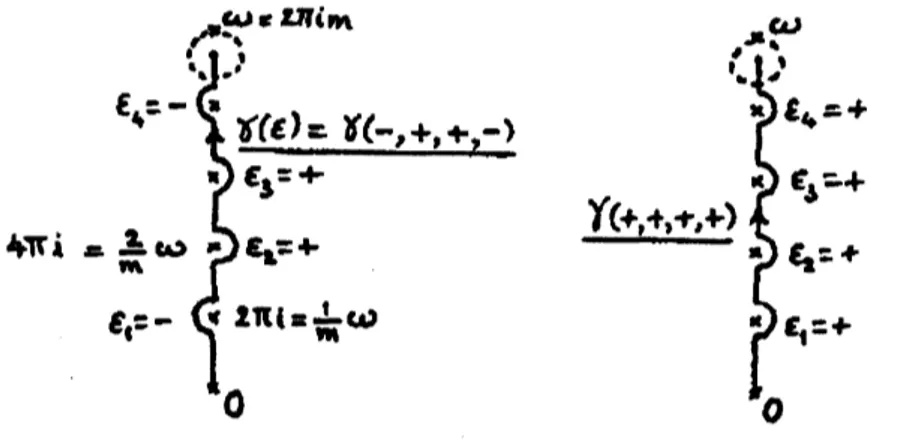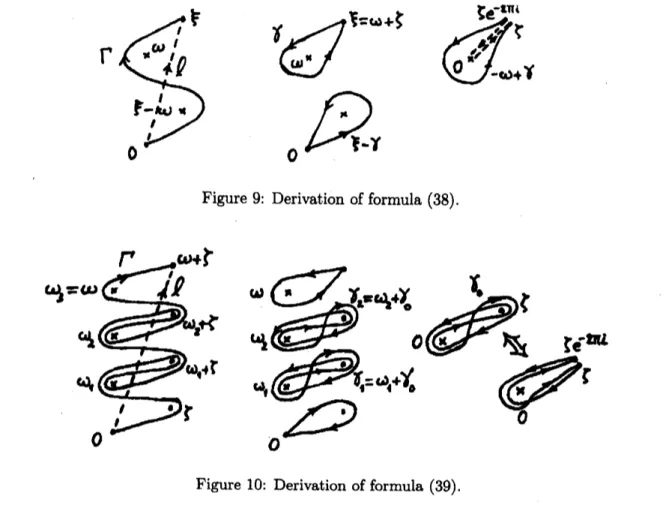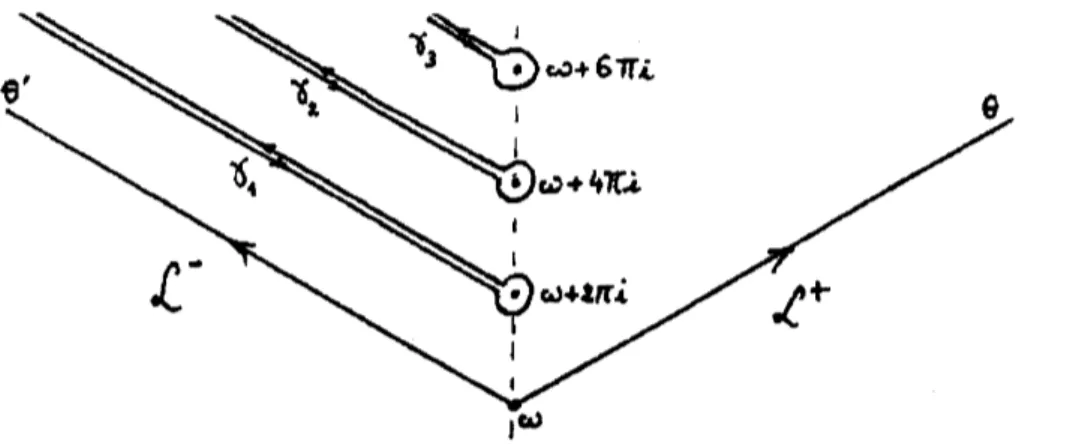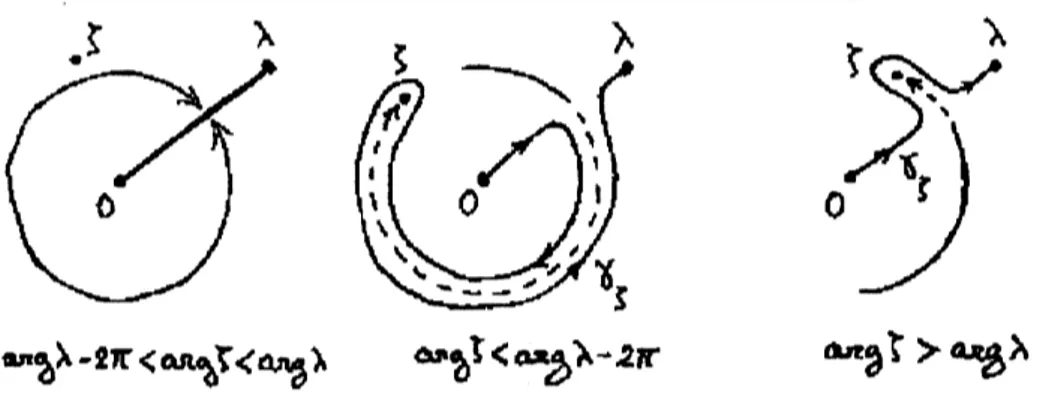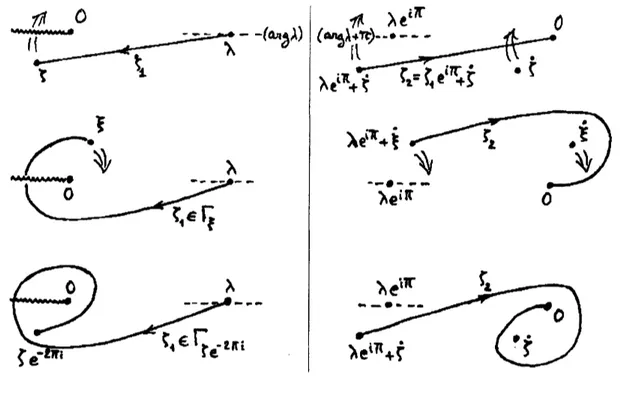Resurgent
functions
and
splitting
problems
David
Sauzin
(CNRS-IMCCE, Paris)デイビット・ソザン (天体力学研究所、パリ)
April 26, 2006
Abstract
The present text is an introduction to
\’Ecalle’s
theory ofresurgent functions and aliencalculus, in connectionwithproblems of exponentiallysmallseparatrixsplitting. Anoutline
oftheresurgenttreatmentofAbel’sequationfor resonant dynamics inonecomplexvariable
is included. Some proofs and detailsareomitted. Theemphasis isonexamplesof nonlinear difference equations, as asimple and natural way of introducing the concepts.
Contents
1 The algebra of resurgent functions 3
1.1 Formal Borel transform
.
3
Fine Borel-Laplace summation
3
Sectorial
sums.
4Resurgent
functions.
. .
6
1.2 Linear and nonlinear difference equations 6
Two linear$eq\mathrm{u}$ations 6
Nonlinear equations
.
..
.
.
.
.
.
.
.
. .
81.3 The Riemann surface$\mathcal{R}$ and the analytic continuation of convolution.
8
The problem
of
analytic continuation. 8The Riemann
surface
72. .
.
.
9
Andytic continuation
of
convolution in$\mathcal{R}$.
. .
.
.
.
.
.
.
10
1.4 Formal and convolutive models ofthe algebra of resurgent functions, $\tilde{\mathcal{H}}$
and $\hat{\mathcal{H}}(\mathcal{R})13$
$2$ Alien calculus and Abel’s equation 14
2.1 Abel’s equation and $\mathrm{t}\mathrm{a}\mathrm{n}\mathrm{g}\mathrm{e}\mathrm{n}\mathrm{t}\sim \mathrm{t}\mathrm{o}$-identity holomorphic germs of$(\mathbb{C}, 0)$ 15
Non-degenerate parabolic germs. 15
The related
difference
equations 16Resurgence in the case $\rho=0$
.
.
.
.
.
.
..
.
172.2 Sectorial normalisations (Fatou coordinates) and nonlinear Stokes phenomenon
(horn maps).
.
.
. .
19Splitting
of
the invariantfoliation.
.
..
. .
212.3 Alien calculus for simple resurgent fuctions
Simple resurgent
functions.
Alien derivations
.
2.4 Bridge equation for non-degenerate parabolic germs
\’Ecalle’s
analytic invariantsRelation with the $hom$ maps.
.
. .
.
. .
. ..
..
Alien derivations as components
of
the logarithmof
the Stokes automorphism23 23 25 30 31 32 35
3 Formalism ofsingularities, general resurgent functions and alien derivations S8
3.1 General singularities. Majors and minors. Integrable singularities. 39
3.2 The convolution algebra SING
.
42Convolution with integrable singularities
.
.
.
.. .
.
.
43Convolution
of
general singularities. The convolution algebra SING. 46Extensions
of
theformal
Boreltransform.
50Laplace
transfom
of
majors.. .
.
.
.
503.3 General resurgent functions and alien derivations
.
.
.
.
.
51Bridge equation
for
non-degenerate parabolic germs in the case $\rho\neq 0$ 534 Splitting problems 55
4.1 Second-orderdifferenceequations and complex splitting problems. 55
Formal sepamtrix.
.
55First resurgence relations
.
.
.. .
.
.
57
The parabolic
curwes
$p^{+}(z)$ and$p^{-}(z)$ and their splitting 60Formal integral and Bridge equation 62
4.2 Real splitting problems.
.
.
..
.
64Two examples
of
exponentially small splitting 64The map $F$ as “innersystem“ 65
Towardsparametric resurgence .
.
.
66
4.3 Parametric resurgence for a cohomological equation.
.
.
671
The algebra of resurgent
functions
Our first purpose is topresent a partof
\’Ecalle’s
theoryofresurgent functions and aliencalculusin a self-contained way. Our main sources are the series of books [Eca81] (mainly the first
two volumes), a course taught by Jean
\’Ecalle
at Paris-Sud university (Orsay) in 1996 and the book [CNP93].1.1
Formal Borel
transform
Aresurgent function
can
beviewedas
aspecialkindof power series, the radiusof convergence ofwhich is zero, but which
can
begiven ananalytical meaningthrough Borel-Laplace summation.Itisconvenient todeal withformal series “at infinity”, $i.e$
.
with elements of$\mathbb{C}[[z^{-1}]]$.
Wedenoteby $z^{-1}\mathbb{C}[[z^{-1}]]$ the subset of formal series without constant term.
Deflnition 1 The
formd
Boreltransform
is the linear operator$B$ :
$\tilde{\varphi}(z)=\sum_{n\geq 0}\mathrm{c}_{n}z^{-n-1}\in z^{-1}\mathbb{C}[[z^{-1}]]$ $rightarrow\hat{\varphi}(\zeta)=\sum_{n\geq 0}c_{n}\frac{\zeta^{n}}{n!}\in \mathbb{C}[[\zeta]]$
.
(1)Observe that if$\tilde{\varphi}(z)$ has
nonzero
radius ofconvergence, say if$\tilde{\varphi}(z)$ converges for $|z^{-1}|<\rho$,then $\hat{\varphi}(\zeta)$ defines an entire function, ofexponential type in every direction: if $\tau>\rho^{-1}$, then $|\hat{\varphi}(\zeta)|\leq \mathrm{c}\mathrm{o}\mathrm{o}\mathrm{t}\mathrm{e}^{\tau|\zeta|}$for all $\zeta\in \mathbb{C}$
.
Deflnition 2 For any $\theta\in \mathbb{R}$, we
define
the Laplacetransform
in the direction $\theta$ as the linearoperator $\mathcal{L}^{\theta}$,
$\mathcal{L}^{\theta}\hat{\varphi}(z)=\int_{0}^{\mathrm{e}^{\mathrm{i}\theta}\infty}\hat{\varphi}(\zeta)\mathrm{e}^{-z\zeta}\mathrm{d}\zeta$
.
(2)
Here, $\hat{\varphi}$ is assumed to be a
fimction
such that $rrightarrow\hat{\varphi}(r\mathrm{e}^{\mathrm{i}\theta})$ is analytic on$\mathbb{R}^{+}$ and $|\hat{\varphi}(r\mathrm{e}^{\mathrm{i}\theta})|\leq$const $\mathrm{e}^{\tau t}$
.
Thefunction
$\mathcal{L}^{\theta}\hat{\varphi}$ is thus analytic in the half-plane$\Re e(z\mathrm{e}^{\mathrm{i}\theta})>\tau$ (see Figure 1).
Recall that $z^{-n-1}= \int_{0n}^{+\infty\zeta}\frac{n}{!}\mathrm{e}^{-z(}\mathrm{d}\zeta$for $\Re ez>0$, thus
$z^{-n-1}= \mathcal{L}^{\theta}(\frac{\zeta^{n}}{n!})$ , $\Re e(z\mathrm{e}^{\mathrm{i}\theta})>0$
.
(3)(For thatreason, $B$ is sometimes called “formal inverseLaplacetransform”.) As a consequence,
if$\hat{\varphi}$ is an entire function of exponential type in every direction, that is if$\hat{\varphi}=B\tilde{\varphi}$with $\tilde{\varphi}(z)\in$
$z^{-1}\mathbb{C}\{z^{-1}\}$, we recover $\tilde{\varphi}$ from $\hat{\varphi}$ by applying the Laplace transform: it can
be
shown1
that$\mathcal{L}^{\theta}\hat{\varphi}(z)=\tilde{\varphi}(z)$ forall $z$ and $\theta$ such that $\Re e(z\mathrm{e}^{\mathrm{i}\theta})$ is large enough.
Fine Borel-Laplace summation
Suppose
now
that $B\tilde{\varphi}=\hat{\varphi}\in \mathbb{C}\{\zeta\}$but $\hat{\varphi}$ is not entire, $i.e.\hat{\varphi}$ has finite radius ofconvergence.
Theradius ofconvergence of
1
isthenzero.
Still, it mayhappenthat$\hat{\varphi}(\zeta)$ extends analyticallyto a half-strip $\{\zeta\in \mathbb{C}|\mathrm{d}\mathrm{i}\mathrm{s}\mathrm{t}(\zeta,\mathrm{e}^{\mathrm{i}\theta}\mathbb{R}^{+})\leq\rho\}$, with exponential type less than a
$\tau\in$ R. In such
a case, formula (2) makes
sense
and the formal series $\tilde{\varphi}$ appears as the asymptotic expansion1 Here, assometimes in this text, weomit the details of the proof. See
$e.g$. [Ma195] for the properties of the
Figure 1: Laplace integral in the direction $\theta$
gives rise to functions analytic in the half-plane
$\Re e(z\mathrm{e}^{\mathrm{i}\theta})>\tau$
.
of$\mathcal{L}^{\theta}\hat{\varphi}$ in the half-plane
$\{\Re e(z\mathrm{e}^{\mathrm{i}\theta})>\max(\tau, 0)\}$ $($as can be deduced ffom (3)$)^{2}$
.
This ismore
or
less the classical definition of a “Borel-summable” formal series $\tilde{\varphi}$.
Onecan
consider thefunction $\mathcal{L}^{\theta}\mathcal{B}\tilde{\varphi}$ as a “sum” of
$\tilde{\varphi}$, associated with the direction $\theta$
.
This summation is called“fine” when $\hat{\varphi}$ is only known to extend to a half-strip in the direction
$\theta$, which is sufficient for
recovering $\tilde{\varphi}$
as
asymptotic expansion of $\mathcal{L}^{\theta}\hat{\varphi}$;more
often, Borel-Laplacesums are
associated
with sectors.
Note: Rom the inversion of the Fourier transform,
one
can deducea
formula for theinte-gral Borel
transform
which allowsone
to recover $\hat{\varphi}(\zeta)$ from $\mathcal{L}^{\theta}\hat{\varphi}(z)$.
For instance, $\hat{\varphi}(\zeta)=$$\frac{1}{2\pi \mathrm{i}}\int_{\rho-\mathrm{i}\infty}^{\rho+\mathrm{i}\infty}\mathcal{L}^{0}\hat{\varphi}(z)\mathrm{e}^{z\zeta}\mathrm{d}z$for small
$\zeta\geq 0$, with suitable$\rho>0$
.
$Se\mathrm{c}$torial
sums
Suppose that $\hat{\varphi}(\zeta)$ converges
near
the origin and extends analytically to a sector$\{\zeta\in \mathbb{C}|\theta_{1}<$
$\arg\zeta<\theta_{2}\}$ (where $\theta_{1},$$\theta_{2}\in \mathbb{R},$ $|\theta_{2}-\theta_{1}|<2\pi$), with exponential type less than $\tau$, then
we
canmovethedirection of integration$\theta \mathrm{i}\mathrm{n}\mathrm{s}\mathrm{i}\mathrm{d}\mathrm{e}$]$\theta_{1},$$\theta_{2}$[. According to the Cauchytheorem, $\mathcal{L}^{\theta’}\hat{\varphi}$ is the analytic continuation of$\mathcal{L}^{\theta}\hat{\varphi}$ when $|\theta’-\theta|<\pi$, we can thus glue together these holomorphic
functionsandobtaina function$\mathcal{L}^{]\theta_{1},\theta_{2}[}\hat{\varphi}$
analyticintheunionof the half-planes $\{\Re e(z\mathrm{e}^{\mathrm{i}\theta})>\tau\}$,
which is
a
sectorial neighbourhood of infinity contained in $\{-\theta_{2}-\pi/2<\arg z<-\theta_{1}+\pi/2\}$(see Figure 2). Notice however that, if$\theta_{2}-\theta_{1}>\pi$, the resulting function may be multivalued,
$i.e$
.
one
must consider the variable $z$ as moving on theRiemann surface of the logarithm.A frequent situation is the following: $\hat{\varphi}=\mathcal{B}\tilde{\varphi}$ converges and extends analytically to several
infinite sectors, with bounded exponential type, but also has singularities at finite distance (in
particular $\hat{\varphi}$ hasfinite radius ofconvergence and
$\tilde{\varphi}$ is divergent). Then several “Borel-Laplace
sums” are available onvariousdomains, butare not the analyticcontinuations one of the other:
the presence of singularities, which separate the sectors one from the other, prevents onefrom
applying the Cauchy theorem. On theother hand, all these “sums” share the same asymptotic
expansion: the mutual differences are exponentially small in the intersection of their domains
of definition (see Figure 3).
Figure 2: Sectorial
sums.
Figure3: SeveralBorel-Laplacesums, analytic indifferent domains,may be attached toasingle
Resurgent
functions
It is interesting to “measure” the singularities in the $\zeta$-plane, since they
can
be consideredas
responsible for thedivergence ofthe
common
asymptotic expansion $\tilde{\varphi}(z)$ and for theexponen-tially small differences between the various Borel-Laplace
sums.
The resurgent functions canbe defined
as
a class of formal series $\tilde{\varphi}$ such that the analytic continuation of the formal Boreltransform $\hat{\varphi}$ satisfies a certain
condition regarding the possible singularities, which makes it
possible to develop a kind of singularity calculus (named “alien calculus”). These notions were
introduced in the late $70\mathrm{s}$ by J.
\’Ecalle,
who provedtheir relevance in a number of analytic
problems [Eca81, Ma185]. We shall not try to expoundthe theory in its full generality, but shall
rather content ourselves withexplaininghow it works in thecase ofcertaindifference equations.
Note: The formal Borel transform of a series $\tilde{\varphi}(z)$ has positive radius ofconvergence if and
only if$\tilde{\varphi}(z)$ satisfies a “Gevrey-l” condition:
$\hat{\varphi}(\zeta)\in \mathbb{C}\{\zeta\}\Leftrightarrow\tilde{\varphi}(z)\in z^{-1}\mathbb{C}[[z^{-1}]]_{1}$ , where by
definition
$z^{-1}\mathbb{C}[[z^{-1}]]_{1}=$
{
$\sum_{n\geq 0}c_{n}z^{-n-1}|\exists\rho>0$such that$|c_{n}|=O(n!\rho^{n})$
}.
1.2
Linear and nonlinear
difference
equationsWe shall be interested in formal series $\tilde{\varphi}$ solutions of certain equations involving the first-order
difference operator $\tilde{\varphi}(z)\mapsto\tilde{\varphi}(z+1)-\tilde{\varphi}(z)$ (orsecond-order differences). Thisoperator is well
defined in$\mathbb{C}[[z^{-1}]],$ $e.g$. byway ofthe Taylor formula
$\tilde{\varphi}(z+1)-\tilde{\varphi}(z)=\partial\tilde{\varphi}(z)+\frac{1}{2!}\partial^{2}\tilde{\varphi}(z)+\frac{1}{3!}\partial^{3}\tilde{\varphi}(z)+\cdots$
,
(4)where$\partial=\frac{\mathrm{d}}{\mathrm{d}z}$ andthe series is formally
convergent because of increasing valuations (wesay that
the series $\sum\frac{1}{r!}\partial^{f}\tilde{\varphi}$ is formally convergent because the right-hand side of
(4) is a well-defined
formal series, each coefficient of which is given by a finite sum of terms; this is the notion of
sequential convergence associated with the so-called Krulltopology).
It is elementary tocompute the counterpart of the differential and differenceoperatorsby$\mathcal{B}$:
$B$ : $\partial\tilde{\varphi}(z)-\rangle-\zeta\hat{\varphi}(\zeta)$, $\tilde{\varphi}(z+1)rightarrow \mathrm{e}^{-\zeta}\hat{\varphi}(\zeta)$
.
When$\tilde{\varphi}(z)$isobtainedbysolvinganequation, anaturalstrategy isthusto study
$\hat{\varphi}(\zeta)$
as
solutionof a transformed equation. If a Laplace transform $\mathcal{L}^{\theta}$
can
be applied to$\hat{\varphi}$,
one
thenrecovers
an
analytic solutionofthe original equation, because $\mathcal{L}^{\theta}\mathrm{o}B$ commuteswith the differential anddifference operators.
Two linear equations
Let
us
illustrate thison two simpleequations:$\tilde{\varphi}(z+1)-\tilde{\varphi}(z)=a(z)$
,
$a(z)\in z^{-2}\mathbb{C}\{z^{-1}\}$ given, (5)$\tilde{\psi}(z+1)-2\tilde{\psi}(z)+\tilde{\psi}(z-1)=b(z)$
,
$b(z)\in z^{-3}\mathbb{C}\{z^{-1}\}$ given. (6)The correspondingequations for the formal Borel transforms are
$\theta_{\backslash }’\backslash$ $2|\iota\pi_{1\mathfrak{n}^{J}}|.\theta$ $\ovalbox{\tt\small REJECT}rightarrow$ 1 $ $’\gamma$ $\backslash \bullet$
,
$ $t$,
$arrow—-\sim-\backslash |’arrow-\sim$ 1 1 $e$ $\uparrow$ $1$1
Figure 4: Borel-Laplace summation for thedifferenceequation (5).
Here the power series \^a$(\zeta)$ and $\hat{b}(\zeta)$ converge to entire functions ofbounded exponential type
in every direction, vanishing at the origin;
moreover
$\hat{b}’(0)=0$.
We thus get in $\mathbb{C}[[\zeta]]$ uniquesolutions $\hat{\varphi}(\zeta)=\hat{a}(\zeta)/(\mathrm{e}^{-\zeta}-1)$ and $\hat{\psi}(\zeta)=\hat{b}(\zeta)/(4\sinh^{2\zeta})2$
’ which converge near the origin
and define meromorphic functions, the possible poles beinglocated in $2\pi \mathrm{i}\mathbb{Z}^{*}$
.
The original equations thus admit unique solutions$\tilde{\varphi}=\mathcal{B}^{-1}\hat{\varphi}$and $\tilde{\psi}=B^{-1}\hat{\psi}$in $z^{-1}\mathbb{C}[[z^{-1}]]$
.
For each ofthem, Borel-Laplace summation is possibleand weget two natural sums, associated
with two sectors:
$\varphi^{+}(z)=\mathcal{L}^{\theta}\hat{\varphi}(z)$, $\theta\in]-\frac{\pi}{2},$$\frac{\pi}{2}[, \varphi^{-}(z)=\mathcal{L}^{\theta’}\hat{\varphi}(z), \theta’\in]\frac{\pi}{2},3\tau\pi[$ ,
and similarly $\hat{\psi}(\zeta)$ gives rise to $\psi^{+}(z)$ and $\psi^{-}(z)$
.
The functions $\varphi^{+}$ and $\psi+\mathrm{a}\mathrm{r}\mathrm{e}$ solutions of (5) and (6), analytic in a domain of the form
$D^{+}=\mathbb{C}\backslash \{\mathrm{d}\mathrm{i}\mathrm{s}\mathrm{t}(z,\mathbb{R}^{-})\leq ar\}$
.
Thesolutions $\varphi^{-}$ and $\psi^{-}$ aredefined ina
symmetric domain$D^{-}$(see Figure 4). The intersection $D^{+}\cap D^{-}$ hae two connected components, $\{\Im mz<-\mathcal{T}\}$ and
$\{\Im mz>\tau\}$. In thecaseofequation (5) for instance, theexponentiallysmalldifference$\varphi^{+}-\varphi^{-}$
in the lower component is related to thesingularities of$\hat{\varphi}$ in$2\pi \mathrm{i}\mathrm{N}^{*};$ it
can
beexactlycomputedby the resiuduum formula: the singularity at $\omega=2\pi \mathrm{i}m$yieldsacontribution
A $\mathrm{e}^{-}"$, with $A_{\omega}=-2\pi \mathrm{i}\hat{a}(\omega)$
(the modulus of which is $|A_{\omega}|\mathrm{e}^{2\pi m\Im mz}$, which is exponentially small for $\Im mzarrow-\infty$); the
difference $( \varphi^{+}-\varphi^{-})(z)=\int_{\mathrm{e}^{\mathrm{i}\theta}\infty}^{\mathrm{e}^{\mathrm{i}\theta}\infty},\hat{\varphi}(\zeta)\mathrm{e}^{-z\zeta}\mathrm{d}\zeta$ is simply the
sum
ofthese contributions:
$\varphi^{+}(z)-\varphi^{-}(z)=‘\sum_{v\in 2\pi \mathrm{i}\mathrm{N}^{*}}A_{\omega}\mathrm{e}^{-\omega z}$, $\Im mz<-\tau$ (7)
as
is easily seen by deforming the contour of integration (choose $\theta$ and $\theta’$ close enough to $\pi/2$accordingto theprecise location of$z$, and pushthe contour of integration upwards).
Symmetri-cally, thedifferenceinthe upper component canbecomputedfrom the singularities $\mathrm{i}\mathrm{n}-2\pi \mathrm{i}\mathrm{N}^{*}$
.
Note: $\varphi^{+}(z)$ is theuniquesolution of(5)which tends to$0$when$\Re ezarrow+\infty$and
can
be written$\Re ezarrow-\infty$; the difference defines two 1-periodic functions, the Fourier
coefficients of which
can be expressed in term of the Fourier transform of $a(\pm \mathrm{i}\rho+z)$ (take $\rho>0$ large enough).
One
recovers
thepreviousformula for the difference by usingthe integral representation fortheBorel transform to compute the numbers \^a$(\omega)$
.
Nonlinear equations
In the present text we shall showhowone can deal with nonlinear difference equations like
$\tilde{\varphi}(z+1)-\tilde{\varphi}(z)=a(z+\tilde{\varphi}(z))$, $a(z)\in z^{-2}\mathbb{C}\{z^{-1}\}$ given, (8)
which is related to Abel’s equation and theclassification of holomorphic germs inone complex
variable, or
$\tilde{\psi}(z+1)-2\tilde{\psi}(z)+\tilde{\psi}(z-1)=b(\tilde{\psi}(z),\tilde{\psi}(z-1))$, (9)
with certain $b(x, y)\in \mathbb{C}\{x, y\}$, which is related to splitting problems in two complex variables.
Dealing with nonlinear equations will require thestudyof convolution,which is the subject
of sections 1.3 and 1.4. The Borel transforms $\hat{\varphi}(\zeta)$ and $\hat{\psi}(\zeta)$ will still be holomorphic at the
origin but
no
longer meromorphic in $\mathbb{C}$, as will be shown later; their analytic continuationshave
more
complicated singularities than mere first- or second-order poles. We shall introducealien calculus in Section 2 and a more general version of it in Section 3.3 to deal with these
singularities.
1.3 The
Riemann
surface
$R$and the
analyticcontinuation of convolution
The first nonlinear operation tobe studied is the multiplication offormal series.
Lemma 1 Let$\hat{\varphi}$ and
th
denote theformal
Boreltransforms
of
$\tilde{\varphi},\tilde{\psi}\in z^{-1}\mathbb{C}[[z^{-1}]]$ and considerthe prvduct series$\tilde{\chi}=\tilde{\varphi}\tilde{\psi}$
.
Then itsforrnal
Bordtransform
is given by the “convolution”$(B \tilde{\chi})(\zeta)=(\hat{\varphi}*\hat{\psi})(\zeta)=\int_{0}^{\zeta}\hat{\varphi}(\zeta_{1})\hat{\psi}(\zeta-\zeta_{1})\mathrm{d}\zeta_{1}$
.
(10)The above formula must be interpreted termwise: $\int_{0n!}^{\zeta\zeta^{n}}\perp\frac{(\zeta-\zeta_{1})^{\mathrm{n}}}{m!},\mathrm{d}\zeta_{1}=\frac{\zeta^{n+m+1}}{(n+m+1)!}$ (as can be
checked $e.g$
.
by inductionon $n$, which is sufficient toprove the lemma).The$p$rvblem
of
analytic continuationThe formula
can
be givenan
analytic meaning in thecase
of Gevrey-l formal series: if$\hat{\varphi},\hat{\psi}\in$$\mathbb{C}\{\zeta\}$, their convolution is convergent inthe intersection of the discs ofconvergence of$\hat{\varphi}$ and
di
and defines a new holomorphic germ $\hat{\varphi}*\hat{\psi}$ at the origin; formula (10) then holds as a relation
between holomorphic functions, but only for $|\zeta|$ small enough (smaller than theradii of
conver-gence of $\hat{\varphi}$ and $\hat{\psi}$). What about the analytic continuation of$\hat{\varphi}*\hat{\psi}$ when $\hat{\varphi}$ and $\hat{\psi}$ themselves
admitananalytic continuation beyondtheir discs ofconvergence? What about the
case
when$\hat{\varphi}$and
th
extend to meromorphic functions for instance?A preliminary
answer
is that $\hat{\varphi}*\hat{\psi}$ always admit ananalytic continuation in the intersectionof the “holomorphicstars” of $\hat{\varphi}$ and
$\hat{\psi}$
.
We define theholomorphic star ofagerm
as
the unionare star-shaped withrespect to the origin $(i.e. \forall\zeta\in U, [0, \zeta]\subset U)$
.
And it is indeed clear thatif $\hat{\varphi}$ and
$\hat{\psi}$
are
holomorphic in such a $U$, formula (10) makessense
forall $\zeta\in U$ and provides
the analytic continuation of$\hat{\varphi}*\hat{\psi}$
.
With aview to further use we notice that, if$|\hat{\varphi}(\zeta)|\leq\Phi(|\zeta|)$
and $|\hat{\psi}(\zeta)|\leq\Psi(|\zeta|)$ for all $\zeta\in U$, then
$|\hat{\varphi}*\hat{\psi}(\zeta)|\leq\Phi*\Psi(|\zeta|)$, $\zeta\in U.$ (11)
The next step is to study what happens on singular rays, behind singular points. The idea
is that convolution ofpoles generates ramification $(” \mathrm{m}\mathrm{u}\mathrm{l}\mathrm{t}\mathrm{i}\mathrm{v}\mathrm{a}\mathrm{l}\mathrm{u}\mathrm{e}\mathrm{d}\mathrm{n}\mathrm{e}\mathrm{s}\mathrm{s}" )$ but is easy to continue
analytically. For example, since
$1* \hat{\varphi}(\zeta)=\int_{0}^{\zeta}\hat{\varphi}(\zeta_{1})\mathrm{d}\zeta_{1}$,
we
see
that when $\hat{\varphi}$ is a meromorphic function with poles ina
set $\Omega\subset \mathbb{C}^{*},$ $1*\hat{\varphi}$ admitsan
analytic continuation along any path issuingfrom the origin and avoidingSt; in other words, it
defines a functionholomorphic
on
the universalcover3
of$\mathbb{C}\backslash \Omega$,
with logarithmic singularitiesat the poles of$\hat{\varphi}$
.
But convolution may also create
new
singular points. For instance, if $\hat{\varphi}(\zeta)=\frac{1}{(-\omega}$, and$\hat{\psi}(\zeta)=\frac{1}{\zeta-\omega},$, with$\omega’,\omega’’\in \mathbb{C}^{*}$, one gets
$\hat{\varphi}*\hat{\psi}(\zeta)=\frac{1}{\zeta-\omega}(\int_{0}^{\zeta}\frac{\mathrm{d}\zeta_{1}}{\zeta_{1}-\omega’}+\int_{0}^{\zeta}\frac{\mathrm{d}\zeta_{1}}{\zeta_{1}-\omega’’})$ , $\omega=\omega’+\omega’’$
.
We thushavelogarithmic singularities at$\omega’$ and$\omega’’$, but alsoa
pole at $\omega$, the residuum of which
is an integer multiple of$2\pi \mathrm{i}$ which depends
on
the path chosen to approach$\omega$
.
In other words, $\hat{\varphi}*\hat{\psi}$extends meromorphically to the universalcover
of$\mathbb{C}\backslash \{\omega’,\omega’’\}$, with a pole lying
over
$\omega$(the residuum ofwhich depends on the
sheet4
ofthe Riemann surface which is considered; inparticular it vanishes for the principal
sheet5
if$\arg\omega’\neq\arg\omega’’$, which is consistent with whatwas previouslysaid on the holomorphic star).
The Riemann
surface
$\mathcal{R}$With
a
view to the difference equations weare
interested in and to the expected behaviour ofthe Borel transforms, we definea Riemann surface which is obtained by adding a point to the
universal
cover
of$\mathbb{C}\backslash 2\pi \mathrm{i}$Z.3 Hereitis understood that the base.pointis at the origin. If$\Omega$isa closed subset of$\mathbb{C}$with$\mathbb{C}\backslash \Omega$connected
and $\zeta 0\in \mathbb{C}\backslash \Omega$, the universalcover of$\mathbb{C}\backslash \Omega$with base-point $\zeta 0$ can be definedas the set of homotopyclasses of
$\mathrm{p}\mathrm{a}\underline{\mathrm{t}\mathrm{h}\mathrm{s}}$issuingfrom$\zeta 0$ andlying in
$\mathbb{C}\backslash \Omega$(
$\mathrm{e}\underline{\mathrm{q}\mathrm{u}\mathrm{i}\mathrm{v}}\mathrm{a}\mathrm{l}\mathrm{e}\mathrm{n}\mathrm{c}\mathrm{e}$classes forhomotopywith fixedextremities). We denote it
$(\mathbb{C}\backslash \Omega, \zeta 0)$
.
There isacovering map$\pi$: $(\mathbb{C}\backslash \Omega, \zeta 0)arrow \mathbb{C}\backslash \Omega$,which associates with any class$c$the extremity$\gamma(1)$of$\mathrm{a}\mathrm{n}\underline{\mathrm{y}\mathrm{p}\mathrm{a}\mathrm{t}}\mathrm{h}\gamma$ :
$[0,1]arrow \mathbb{C}\backslash \Omega$which represents $c$, and which allows one todefine a Riemannsurface structure
on$(\mathbb{C}\backslash \Omega, \zeta 0)$by pullingbackthe complex structure of$\mathbb{C}\backslash \Omega$(see [CNP93,pp. 81-89and 105-112]). Forexample,
the Riemann surfaceofthe logarithm is $(\mathbb{C}\backslash \{0\}, 1)$, thepointsof which canbewritten “$r\mathrm{e}^{\mathrm{i}\theta}$”
with $f>0$ and
$\mathit{9}\in$R. We oftenusetheletter$\zeta$for pointsofauniversal cover, and then denote by $\zeta=\pi(\zeta)$ their projection.
4Againwecantake the base-point at the origin to define theuniversalcoverof$\mathbb{C}\backslash \Omega$, here with$\Omega=\{\omega‘, \omega’’\}$
.
The word “sheets” usuallyrefers to the various lifts in thecoverofanopensubset $U$of thebasespace which is
star-shapedwithrespectto oneof its $\underline{\mathrm{p}\mathrm{o}\mathrm{i}\mathrm{n}\mathrm{t}\mathrm{s}},$$i.e$
.
tothevarious connectedcomponentsof$\pi^{-1}(U)$.
5In thecaseofa universalcover $(\mathbb{C}\backslash \Omega, \zeta 0)$, the “principal sheet” $\tilde{U}$
isobtainedbyconsidering the maximal open subset$U$of$\mathbb{C}\backslash \Omega$ which isstar-shaped withrespectto$\zeta 0$ andliftingitbymeansof rectilinearsegments: $\tilde{U}$
Definition 3 Let$\mathcal{R}$ be theset
of
all homotopy classesof
paths issuingfrom
the $\mathit{0}$rigin and lyin9znside $\mathbb{C}\backslash 2\pi \mathrm{i}\mathbb{Z}$ (except
for
their initialpoint), and let$\pi$ : $\mathcal{R}arrow \mathbb{C}\backslash 2\pi \mathrm{i}\mathbb{Z}^{*}$ be the covering map,
whichassociates with any class$c$ the extremity$\gamma(1)$
of
anypath$\gamma$ : $[0,1]$ —$\mathbb{C}$ which represents
$c$
.
We consider$\mathcal{R}$ as a Riemann
surface
by pulling back by$\pi$ the complex structureof
$\mathbb{C}\backslash 2\pi \mathrm{i}\mathbb{Z}^{*}$.Observe that $\pi^{-1}(0)$ consists of only one point (the homotopy class of the constant path),
which we may call the origin of$\mathcal{R}$
.
Let $U$ be the complex planedeprived from the half-lines
$+2\pi \mathrm{i}[1,$$+\infty$[ and $-2\pi \mathrm{i}[1,$$+\infty$[. We define the “principal sheet” of $\mathcal{R}$ as the set of all the
classes ofsegments $[0, \zeta],$ $\zeta\in U$; equivalently, it is the connected component of$\pi^{-1}(U)$ which
contains the origin. We define the “half-sheets” of $\mathcal{R}$ as the various connected components
of$\pi^{-1}(\{\Re e\zeta>0\})$ or of$\pi^{-1}(\{\Re e\zeta<0\})$
.
A holomorphic function of$\mathcal{R}$ can beviewed as a germof holomorphic
functionat theorigin
of$\mathbb{C}$ which admits analytic continuation
along any path avoiding $2\pi \mathrm{i}\mathbb{Z}$; we then say that this
germ “extends holomorphically to $\mathcal{R}$”. This definition a
priori does not authorize analytic
continuation along
a
path which leads to the origin, unless this path stays in the principalsheet6.
More precisely, one canproveLemma 2
If
$\Phi$ is holomorphic in$\mathcal{R}$, then its restriction to theprincipal sheet
defines
aholo-mo$r\mathrm{p}hic$
function
$\varphi$
of
$U$ which extends analytically along any path$\gamma$ issuing
ffom
$0$ and lyingin$\mathbb{C}\backslash 2\pi \mathrm{i}$Z. The analytic continuation is given by
$\varphi(\gamma(t))=\Phi(\Gamma(t))$, where $\Gamma$ is the
lift of
$\gamma$which starts at the $or\dot{\tau}gin$
of
R.Conversely, given $\varphi\in \mathbb{C}\{\zeta\}$,
if
any $c\in \mathcal{R}$ can be represented by a pathof
andyticcontin-uation
for
$\varphi$, then the valueof
$\varphi$ at the extremity 7(1)
of
this path depends onlyon
$c$ and theformula
$\Phi(c)=\varphi(\gamma(1))$defines
a holomorphicfunction of
72.The absence of singularity at the originonthe principalsheetistheonlydifference between$R$
and the universal
cover
of$\mathbb{C}\backslash 2\pi \mathrm{i}\mathbb{Z}$ withbase-point at 1. For instance, among thetwo series$\sum_{m\in \mathrm{z}*}\frac{1}{\zeta}\mathrm{e}^{-|m|\int_{1}^{\zeta}\frac{\mathrm{d}\zeta_{1}}{\zeta_{1}-2\pi \mathrm{i}m}}$, $\sum_{m\in \mathrm{z}*}\frac{1}{\zeta}\mathrm{e}^{-|m|\int_{0}^{\zeta}\frac{\mathrm{d}\zeta_{1}}{\zeta_{1}-2\pi \mathrm{i}m}}$,
the first
one
defines a functionwhich is holomorphic in the universal cover of$\mathbb{C}\backslash 2\pi \mathrm{i}\mathbb{Z}$ but notin$\mathcal{R}$, whereas the second
one defines a holomorphic function of R.
Analytic continuation
of
convolution in 72The main result of this section is
Theorem 1
If
twogems at the $\mathit{0}$rigin eztend holomorphically to$\mathcal{R}$, so does their convolutionproduct.
Idea
of
the proof. Let $\hat{\varphi}$ and $\hat{\psi}$ beholomorphic germs at the origin of$\mathbb{C}$ which admit analytic
continuation along anypath avoiding $2\pi \mathrm{i}\mathbb{Z}$; we denote by the same symbolsthe corresponding
$\overline{\epsilon_{\mathrm{T}\mathrm{h}\mathrm{a}\mathrm{t}\mathrm{i}\S},}$unlaesit lies in
$U=\mathbb{C}\backslash \pm 2\pi \mathrm{i}\lfloor 1,$$+\infty$[. We shall often identify the paths issuing$\mathrm{h}\mathrm{o}\mathrm{m}0$in$\mathbb{C}\backslash 2\pi \mathrm{i}\mathrm{Z}$
andtheirliftsstarting atthe origin of R. Sometimes,weshallevenidentifyapoint of$\mathcal{R}$with its projection by$\pi$
(thepath which leads tothispoint being understood), which amounts totreating aholomorphic function of$\prime \mathcal{R}$ as amultivalued functionon$\mathbb{C}\backslash 2\pi \mathrm{i}$Z.
holomorphic functions of$\mathcal{R}$
.
One could be tempted to think that, if a point$\zeta$ of $\mathcal{R}$ is defined
by
a
path $\gamma$, the integral$\hat{\chi}(\zeta)=\int_{\gamma}\hat{\varphi}(\zeta’)\hat{\psi}(\zeta-\zeta’)\mathrm{d}\zeta’$ (12)
would give the value of the analytic continuation of $\hat{\varphi}*\hat{\psi}$ at
$\zeta$
.
However, this formula doesnot always make sense, since one must worry about the path $\gamma’$ followed by $\zeta-\zeta’$ when $\zeta’$
follows $\gamma$: is
$\hat{\psi}$ definedonthispath? Infact, even
if
7‘
liesin$\mathbb{C}\backslash 2\pi \mathrm{i}\mathbb{Z}$ (and thus$\hat{\psi}(\zeta-\zeta’)$ makessense), even if$\gamma’$ coincides with
$\gamma$
,
it may happen that this integral does not give the analyticcontinuation of$\hat{\varphi}*\hat{\psi}$ at
$\zeta$ (usually, the value of thisintegral does not dependonly on
$\zeta$ but also
on
the path$\gamma)^{7}$.
The construction of the desired analytic continuation relies on the idea of “symmetrically
contractile” paths. A path $\gamma$ issuing from $0$ is said to be
$\mathcal{R}$-symmetric if it lies in
$\mathbb{C}\backslash 2\pi \mathrm{i}\mathbb{Z}$
(except for its starting point) and is symmetric with respect to its midpoint: the paths $t\in$ $[0,1]rightarrow\gamma(1)-\gamma(t)$ and $t\in[0,1]rightarrow\gamma(1-t)$ coincide up to reparametrisation. A path is said
to be $\mathcal{R}$-symmetrically contractile if it is $\mathcal{R}$-symmetric and
can
be continuously deformed and
shrunk to $\{0\}$ within the class of$\mathcal{R}$-symmetric paths. The main point is that any
point of$\mathcal{R}$
can be defined by an $\mathcal{R}$-symmetrically contractile path. More
precisely:
Lemma 3 Let$\gamma$ be a path issuing
from
$0$ and lying in $\mathbb{C}\backslash 2\pi \mathrm{i}\mathbb{Z}$ (exceptfor
its startingpoint).Then there exists an $\mathcal{R}$-symmetrically contractile path $\Gamma$ which is homotopic to
$\gamma$
.
Moreover,one can construct$\Gamma$ so that there is a continuous map
$(s,t)\mapsto H(s,t)=H_{s}(t)$ satisfying
$i)H_{0}(t)\equiv 0$ and$H_{1}(t)\equiv\Gamma(t)$,
$ii)$ each $H_{s}$ is an $\mathcal{R}$-symmetricpath utith$H_{s}(0)=0$ and
$H_{s}(1)=\gamma(s)$
.
We shall not try to write
a
formal proof of this lemma, but it is easy to visualizea
wayof constructing $H$
.
Let a point $\zeta=\gamma(s)$ move along $\gamma$ (as $s$ varies from $0$ to 1) and remainconnected to $0$ by an extensible thread, with moving nails pointing downwards at each point
of $\zeta-2\pi \mathrm{i}\mathbb{Z}$, while fixed nails point upwards at each point of $2\pi \mathrm{i}\mathbb{Z}$ (imagine for
instance
thatthe first nails arefastened to amoving rule and the last ones to a fixed rule). As $s$ varies, the
thread is progressively stretched but it has to meander between the nails. The path $\Gamma$ is given
by the thread inits finalform, when$\zeta$ has reached the extremity of7;the paths $H_{s}$ correspond
to the thread at intermediary
stages8
(see Figure 5).It is now easy to end theproofofTheorem 1. Given $\hat{\varphi},\hat{\psi}\wedge$ as above and
$\gamma$ apath of$\mathcal{R}$ along
which we wish to follow the analytic continuation of$\hat{\varphi}*\psi$, we take $H$ as in Lemma3 and let
the reader convince himselfthat the formula
$\hat{\chi}(\zeta)=\int_{H_{\delta}}\hat{\varphi}(\zeta’)\hat{\psi}(\zeta-\zeta’)\mathrm{d}\zeta’$, $\zeta=\gamma(s)$, (13)
defines the analytic continuation $\hat{\chi}$ of$\hat{\varphi}*\hat{\psi}$along
$\gamma$ (in thisformula, $\zeta’$ and$\zeta-\zeta’$ move onthe
same
path $H_{s}$ which avoids $2\pi \mathrm{i}\mathbb{Z}$,
by $\mathcal{R}$-symmetry). See[Eca81, Vol. 1], [CNP93], [GSOI] for
more
details. $\square$7However,if
zb
isentire,it istruethattheintegral (12) doesprovidethe analytic continuation of$\hat{\varphi}*\hat{\psi}$along7.
8Notethat the mere existence of acontinuous $H$ satisfying conditions :) and $ii$) implies that $\gamma$ and $\Gamma$ are
homotopic, asis visually clear (theformula
$h_{\lambda}(t)=H(\lambda+(1-\lambda)t,$ $\frac{t}{\lambda+(1-\lambda)t})$, $0\leq\lambda\leq 1$
$H_{\mathrm{g}\bullet}$
Figure 5: Construction ofan $\mathcal{R}$-symmetrically contractile path $\Gamma$ homotopic to
Ofcourse, if the path $\gamma$ mentionedin the last part ofthe proofstays in the principal sheet
of $\mathcal{R}$, the analytic continuation is simply given by formula
(10). Inparticular, if$\hat{\varphi}$ and
di
havebounded exponential type in a direction $\arg\zeta=\theta,$ $\theta\not\in\frac{\pi}{2}+\pi \mathbb{Z}$, it follows from inequality (11)
that $\hat{\varphi}*\hat{\psi}$ has the same property.
1.4
Formaland convolutive models
ofthe
algebra of resurgentfunctions,
$\tilde{\mathcal{H}}$and
$\hat{\mathcal{H}}(\mathcal{R})$In view of Theorem 1, the convolution of germs induces
an
internal law on the space ofholo-morphic functions of$R$, which is commutative and associative (beingthe counterpart of
multi-plication offormal series, by Lemma 1). In fact, we havea commutative algebra (withoutunit),
which can be viewed
as
a subalgebra of the convolution algebra $\mathbb{C}\{\zeta\}$, and which correspondsvia $B$ to asubalgebra (for the ordinary product offormalseries) of$z^{-1}\mathbb{C}[[z^{-1}]]$
.
Deflnition 4 The space $\hat{\mathcal{H}}(\mathcal{R})$
of
allholomorphicfunctions of
$\mathcal{R}$, equippedunththe convolution
product, is an algebra called the convolutive model
of
the algebraof
resurgentfunctions.
The subalgebra $\tilde{\mathcal{H}}=\mathcal{B}^{-1}(\hat{\mathcal{H}}(R))$of
$z^{-1}\mathbb{C}[[z^{-1}]]$ is called the multiplicative modelof
the algebraof
resungent
functions.
Theformal series in$\tilde{\mathcal{H}}$
(most of which have zeroradius ofconvergence) arecalled “resurgent
functions”. These definitions will in fact be extended to
more
general objects in the following(see Section 3 on “singularities”).
Thereis no unit for the convolution in$\hat{\mathcal{H}}(\mathcal{R})$
.
Introducing a newsymbol $\delta=B1$, weextend
the formal Borel transform:
$B$ :
$\tilde{\chi}(z)=c_{0}+\sum_{n\geq 0}c_{n}z^{-n-1}\in \mathbb{C}[[z^{-1}]]rightarrow\hat{\chi}(\zeta)=c_{0}\delta+\sum_{n\geq 0}\mathrm{c}_{n}\frac{\zeta^{n}}{n!}\in \mathbb{C}\delta\oplus \mathbb{C}[[\zeta]]$,
and also extend convolution from $\mathbb{C}[[\zeta]]$ to C6$\oplus \mathbb{C}[[\zeta]]$ linearly, by treating
5
as a unit ($i.e$.
so
as
tokeep $B$ amorphism ofalgebras). This way, $\mathbb{C}\delta\oplus\hat{\mathcal{H}}(\mathcal{R})$ is an algebrafor the convolution,which is isomorphic via$B$ to the algebra $\mathbb{C}\oplus\tilde{\mathcal{H}}$
.
Observe that
$\mathbb{C}\{z^{-1}\}\subset \mathbb{C}\oplus\tilde{\mathcal{H}}\subset \mathbb{C}[[z^{-1}]]_{1}$
.
Having dealt with multiplication of formalseries, we
can
study compositionand its image in$\mathbb{C}\delta\oplus\hat{\mathcal{H}}(\mathcal{R})$:
Proposition 1 Let $\tilde{\chi}\in \mathbb{C}\oplus\tilde{\mathcal{H}}$. Then composition by
$zrightarrow z+\tilde{\chi}(z)$
defines
a linearopera-tor
of
$\mathbb{C}\oplus\tilde{\mathcal{H}}$ into itself, andfor
any $\tilde{\psi}\in\tilde{\mathcal{H}}$ the Boreltransform of
$\tilde{\alpha}(z)=\tilde{\psi}(z+\tilde{\chi}(z))=$$\sum_{\gamma\geq 0}\frac{1}{r!}\partial^{f}\tilde{\psi}(z)\tilde{\chi}^{r}(z)$ is given by the series
of
functions
a
$( \zeta)=\sum_{r\geq 0}\frac{1}{r!}((-\zeta)^{r}\hat{\psi}(\zeta))*\hat{\chi}^{*r}(\zeta)$ (14)(where $\hat{\chi}=B\tilde{\chi}$ and$\hat{\psi}=\mathcal{B}\tilde{\psi}$), whichis uniformly convergent in every compact subset
The convergence of the series stems from the regularizing character of convolution (the
convergence in the principal sheet of lre can be proved by
use
of (11); see [Eca81, Vol. 1]or [CNP93] for the convergence in thewhole Riemann surface).
The notation $\hat{\alpha}=\hat{\psi}\mathrm{O}*(\delta’+\hat{\chi})$ andthename “composition-convolution” are
usedin [Ma195], with a symbol $\delta’=Bz$ which must be considered as the derivative of$\delta$
.
The symbols $\delta$ and $\delta$‘will be interpreted as elementary singularities in Section 3.
In Proposition 1, the operator of composition by $zrightarrow z+\tilde{\chi}(z)$ is invertible; in fact, $\mathrm{I}\mathrm{d}+\tilde{\chi}$
has a well-defined inverse forcomposition in $\mathrm{I}\mathrm{d}+\mathbb{C}[[z^{-1}]]$, which turnsout to be also resurgent:
Proposition 2
If
$\tilde{\chi}\in \mathbb{C}\oplus\tilde{\mathcal{H}}$, theformal transformation
$\mathrm{I}\mathrm{d}+\tilde{\chi}$ has an inverse (for composition)of
theform
$\mathrm{I}\mathrm{d}+\tilde{\varphi}$ with $\tilde{\varphi}\in\tilde{\mathcal{H}}$.
This can be proven by the
same
arguments as Proposition 1, since the Lagrange inversionformula allows
one
to write$\tilde{\varphi}=\sum_{k\geq 1}\frac{(-1)^{k}}{k!}\partial^{k-1}(\tilde{\chi}^{k})$, hence $\hat{\varphi}=-\sum_{k\geq 1}\frac{\zeta^{k-1}}{k!}\hat{\chi}^{*k}$
.
(15)One canthus think of$zrightarrow z+\tilde{\chi}(z)$
as
ofa “resurgent change of variable”.Similarly, substitution of
a
resurgent functionwithout constant term intoa
convergent seriesis possible:
Proposition 3
If
$C(w)= \sum_{n\geq 0}C_{n}w^{n}\in \mathbb{C}\{w\}$ and$\tilde{\psi}\in\tilde{\mathcal{H}}$, then theformd
$se\sqrt esC\mathrm{o}\tilde{\psi}(z)=$ $\sum_{n\geq 0}C_{n}\tilde{\psi}^{n}(z)$ belongs to $\mathbb{C}\oplus\tilde{\mathcal{H}}$.
The proofconsists in verifying the convergence of the series $B(C \mathrm{o}\tilde{\psi})=\sum_{n\geq 0}C_{n}\hat{\psi}^{\mathrm{x}n}$
.
As a consequence, any resurgent function with
nonzero
constant term has a resurgentmul-tiplicative inverse: $1/(c+ \tilde{\psi})=\sum_{n\geq 0}(-1)^{n}c^{-n-1}\tilde{\psi}^{n}\in \mathbb{C}\oplus\tilde{\mathcal{H}}$
.
The exponential ofa resurgentfunction$\tilde{\psi}$is also a
resurgent function, the Borel transformof which is the convolutive
exponen-tial
$\exp_{*}(\hat{\psi})=\delta+\hat{\psi}+\frac{1}{2!}\hat{\psi}*\hat{\psi}+\frac{1}{3!}\hat{\psi}*\hat{\psi}*\hat{\psi}+\ldots$
(in this
case
the substitution is well-defined even if $\tilde{\psi}(z)$ has a constant term).We end this section by remarking that the role of the lattice $2\pi \mathrm{i}\mathbb{Z}$ in the definition of$R$ is
not essential in the theory of resurgentfunctions. See Section 3.3for amoregeneraldefinition of
the spaceofresurgentfunctions (inwhich the location ofsingularpointsis not apriorirestricted
to$2\pi \mathrm{i}\mathbb{Z}$), witha property ofstabilityby convolutionasinTheorem 1, and with alien derivations
more general than the ones to be defined in Section 2.3.
2
Alien
calculus and Abel’s
equation
We
now
turn to the resurgent treatment of the nonlinear first-order difference equation (8),2.1
Abel’s equation and tangent-to-identity holomorphic
germs
of
$(\mathbb{C}, 0)$One of the origins of
\’Ecalle’s
work on Resurgence theory is the problem of the classificationof holomorphic germs $F$ of $(\mathbb{C}, 0)$ in the “resonant” case. This is the question, important
for one-dimensional complex dynamics, of describing the conjugacy classes of the group $\mathrm{G}$ of
local analytic transformations $w\mapsto F(w)$ which are $1\mathrm{o}c$ally invertible, $i.e$. of the form
$F(w)=$
$\lambda w+O(w^{2})\in \mathbb{C}\{w\}$with$\lambda\in \mathbb{C}^{*}$. It iswell-knownthat, ifthemultiplier
$\lambda=F’(0)$ has modulus
$\neq 1$, then$F$ is holomorphically linearizable: there exists$H\in \mathrm{G}$ such that$H^{-1}\mathrm{o}F\mathrm{o}H(w)=\lambda w$
.
Resurgence comes into play when we consider the resonant case, $i.e$. when $F’(\mathrm{O})$ is a root of
unity (the so-called “small divisor problems”, which appear when $F’(\mathrm{O})$ has modulus 1 but is
not aroot of unity,
are
ofdifferent nature–see S. Marmi’s lecture in this volume).Thereferences forthis part of the text
are:
[Eca81, Vol. 2], [Eca84], [Ma185] (and Example1of [Eca05] p. 235). For non-resurgent approaches of the
same
problem,see
[MR83], [DH84],[Shi98], [ShiOO], [Mi199], [Lor06].
Non-degenerate parabolic germs
Here, for simplicity, we limit ourselves to $F’(\mathrm{O})=1,\acute{\iota}.e$
.
to germs $F$ which are tangent toidentity, with the further requirement that $F”(0)\neq 0$, a condition which is easily seen to be
invariant by conjugacy. Rescaling the variable $w$ if necessary,
one
can suppose $F”(0)=2$.
Itwill be
more
convenient to work “near infinity”, $i.e$.
touse
the variable z—-l/w.Definition 5 We call “non-degenerate parabolic germ at the $\mathit{0}\dot{n}gin’$’
any
$F(w)\in \mathbb{C}\{w\}$of
theform
$F(w)=w+w^{2}+O(w^{3})$
.
We call “non-degenerate parabolic gern at infinity” a
transformation
$zrightarrow f(z)$ which isconju-gated by $z=-1/w$ to a non-degenerateparabolic germ $F$ at the origin:
$f(z)=-1/(F(-1/z))$,
$i.e$
.
any$f(z)=z+1+a(z)$ urith $a(z)\in z^{-1}\mathbb{C}\{z^{-1}\}$.
Let $\mathrm{G}_{1}$ denote the subgroup of
$\mathrm{t}\mathrm{a}\mathrm{n}\mathrm{g}\mathrm{e}\mathrm{n}\mathrm{t}- \mathrm{t}\infty \mathrm{i}\mathrm{d}\mathrm{e}\mathrm{n}\mathrm{t}\mathrm{i}\mathrm{t}\mathrm{y}$germs. One can easily check that, if
$F,$$G\in \mathrm{G}_{1}$ and $H\in \mathrm{G}$, then $G=H^{-1}\circ F\circ H$ implies $G”(\mathrm{O})=H’(\mathrm{O})F’’(\mathrm{O})$. In order to work
with non-degenerate parabolic germs only, we can thus restrictourselves to$\mathrm{t}\mathrm{a}\mathrm{n}\mathrm{g}\mathrm{e}\mathrm{n}\mathrm{t}- \mathrm{t}\mathrm{t}\succ \mathrm{i}\mathrm{d}\mathrm{e}\mathrm{n}\mathrm{t}\mathrm{i}\mathrm{t}\mathrm{y}$
conjugating transformations $H,$ $i.e$
.
wecan
content ourselves with studying the adjoint actionof$\mathrm{G}_{1}$
.
It turns out that formal transformations also play a role. Let $\tilde{\mathrm{G}}_{1}$
denote the group (for
composition) offormal series ofthe form $\tilde{H}(w)=w+O(w^{2})\in \mathbb{C}[[w]]$
.
It may happenthat twoparabolic germs $F$and$G$ areconjugated bysuch
a
formal series $\tilde{H},$ $i.e$.
$G=H^{-1}\mathrm{o}F\mathrm{o}H$ in$\tilde{\mathrm{G}}_{1}$,without beingconjugated by any convergent series: the $\mathrm{G}_{1}$-conjugacy classes we
are
interestedin form a finer partition than the “formal conjugacy classes”.
In fact, the formal conjugacy classes are easy to describe. One cancheck that, for any two
non-degenerate parabolic germs $F(w),$$G(w)=w+w^{2}+O(w^{3})$, there exists $\tilde{H}\in\tilde{\mathrm{G}}_{1}$ such that
$G=H^{-1}\circ F\circ H$ if and only if the coefficient of $w^{3}$ is the
same
in $F(w)$ and $G(w)$.
In theLet us rephrase the problem at infinity, using the variable $z=-1/w$ , and thus dealing
with transformations belonging to $\mathrm{I}\mathrm{d}+\mathbb{C}[[z^{-1}]]$. The formula $h(z)=-1/H(-1/z)$ puts in
correspondence the conjugating transformations $H$ of$\mathrm{G}_{1}$ or $\tilde{\mathrm{G}}_{1}$
and the series ofthe form
$h(z)=z+b(z)$, $b(z)\in \mathbb{C}\{z^{-1}\}$ or $b(z)\in \mathbb{C}[[z^{-1}]]$
.
(16)Given anon-degenerate parabolicgerm at infinity $f(z)=-1/(F(-1/z))$ , the coefficient aof$w^{3}$
in $F(w)$ shows up in the coefficient of$z^{-1}$ in $f(z)$:
$f(z)=z+1+a(z)$ , $a(z)=(1-\alpha)z^{-1}+O(z^{-2})\in \mathbb{C}\{z^{-1}\}$
.
(17)The coefficient $\rho=\alpha-1$ iscalled “r\’esidu it\’eratif’’ in
\’Ecalle’s
work,or “resiter” for short. Thusany two germs
of
theform
(17) are conjugated by aformd
$transfo7mation$of
theform
(16)if
and only
if
they have the same resiter.The related
differe
$n\mathrm{c}\mathrm{e}$ equatio$\mathrm{n}\epsilon$The simplest formal conjugacy class is the
one
corresponding to $\rho=0$.
Any non-degenerateparabolic germ $f$ or $F$with vanishing resiter is conjugated by
a
formal $h$ or $H$ to $zrightarrow f_{0}(z)=$$z+1$ or $w rightarrow F_{0}(w)=\frac{w}{1-w}$
.
We can be slightly more specific:Proposition 4 Let
$f(z)=z+1+a(z)$
be a non-degenerate parabolic germ at infinity withvanishing resiter, $i.e$
.
$a(z)\in z^{-2}\mathbb{C}\{z^{-1}\}$. Then there $e$vists a unique $\tilde{\varphi}(z)\in z^{-1}\mathbb{C}[[z^{-1}]]$ suchthat the$fo7mal$
transformation
$\tilde{u}=\mathrm{I}\mathrm{d}+\tilde{\varphi}$ is solutionof
$u^{-1}\circ f\circ u(z)=z+1$
.
(18)The inverse
formd tmnsformation
$\tilde{v}=\tilde{u}^{-1}$ is the uniquetransformation of
theform
$\tilde{v}=$ $z+\tilde{\psi}(z).$, with $\tilde{\psi}(z)\in z^{-1}\mathbb{C}[[z^{-1}]]$, solutionof
$v(f(z))=v(z)+1$
.
(19)All the other
formal
solutionsof
equations (18) and(19) canbe deducedfrom
$\tilde{u}$ and$\tilde{v}$: theyare
the series
$u(z)=z+c+\tilde{\varphi}(z+c)$, $v(z)=z-c+\tilde{\psi}(z)$, (20)
where $c$ is an arbitrary complex number.
We omit the proof of this proposition, which can be done by substitution of
an
indeter-mined series $u\in \mathrm{I}\mathrm{d}+\mathbb{C}[[z^{-1}]]$ in (18). Setting $v=u^{-1}$, the
$u$-equation then translates into
equation (19), as illustrated on the commutative diagram
$u\downarrow^{Z}|v$ $u\downarrow|z+1$ $v$
$z-f(z)$
$z=-1/w\backslash _{w}\underline{\backslash }_{F(w)}$
Notice that, under the change of unknown $u(z)=z+\varphi(z)$, the conjugacy equation (18) is
equivalent to the equation
$\varphi(z)+a(z+\varphi(z))=\varphi(z+1)$,
$i.e$
.
to the difference equation (8) with$a(z)=f(z)-z-1$
.
Equation (19) is called Abel’sequation9.
Theformal solutions $\tilde{u}$and $\tilde{v}$ mentioned in Proposition4 are
generically divergent. It turns out that they are always resurgent. Before trying to explain this, let us mention that the case
of ageneral resiter $\rho$
can
be handled by studying thesame
equations (18) and (19): if$\rho\neq 0$,there isno solution in$\mathrm{I}\mathrm{d}+\mathbb{C}[[z$‘1]$]$, but one finds aunique formal solution of Abel’s equationof
the form
$\tilde{v}(z)=z+\tilde{\psi}(z)$,
$\tilde{\psi}(z)=\rho\log z+\sum_{n\geq 1}c_{n}z^{-n}$,
the inverse ofwhich is of the form
$\tilde{u}(z)=z+\tilde{\varphi}(z)$, $\tilde{\varphi}(z)=-\rho\log z+$
$\sum_{nm\geq 0_{1},n\dotplus_{m\geq}}C_{n,m}z^{-n}(z^{-1}\log z)^{m}$
,
and these series $\tilde{\psi}$
and $\tilde{\varphi}$ can be treated by Resurgence almost as easily as the corresponding series in thecase $\rho=0$
.
In\’Ecalle’s
work, the formal solution$\tilde{v}$ ofAbel’s equationis called the
iterator(it\’erateur, inIFMrench)of$f$ andits inverse$\tilde{u}$is called the inverse itera$tor$becauseoftheir
role initeration theory (which weshall not develop in this text–see however footnote 16).
Resurgence in the
case
$\rho=0$IFlrom
now on
we focus on the case $\rho=0$, thus with “formal normal forms” $f_{0}(z)=z+1$ atinfinityor$F_{0}(w)= \frac{w}{1-w}$ at the origin. We do not intend togive the complete resurgent solution
ofthe classification problem, but only to convey
some
ofthe ideas used in\’Ecalle’s
approach.Theorem 2 In the case$\rho=0$ (vanishing resiter), the
formal
series$\tilde{\varphi}(z),\tilde{\psi}(z)\in z^{-1}\mathbb{C}[[z^{-1}]]$ interms
of
which the solutionsof
equations (18) and (19) can be expressed as in (20) haveformal
Borel
transfo
$7ms\hat{\varphi}(\zeta)$ and $\hat{\psi}(\zeta)$ which converge near theorigin and extend holomorphically to $\mathcal{R}$, with at most exponential growth in the directions
$\arg\zeta=\theta,$ $\theta\not\in\frac{\pi}{2}+\pi \mathbb{Z}$ (for every
$\theta_{0}\in]0,$$\frac{\pi}{2}$
[,
there exists $\tau>0$ such that $\hat{\varphi}$ anddi
have exponential $type\leq\tau$ in the sectors$\{-\theta_{0}+n\pi\leq\arg\zeta\leq\theta_{0}+n\pi\},$ $n=0$
or
1).In other words, Abel’s equation gives rise to resurgent functions and it is possible to apply
the Borel-Laplace summation process to $\tilde{\varphi}$ and $\tilde{\psi}$
.
Idea
of
theproof. Equation (19) for $v(z)=z+\psi(z)$ translates intoth
$(z+1+a(z))-\psi(z)=-a(z)$.
(21)The proofindicated in [Eca81, Vol. 2] or [Ma185] relies onthe expressionof theunique solution in$z^{-1}\mathbb{C}[[z^{-1}]]$ as aninfinitesumof iteratedoperators appliedto$a(z)$; theformal Borel transform
9In fact, thisname usuallyrefers to the equation $V\mathrm{o}F=V+1$, for $V(w)=v(-1/w)$, which expresses the
conjugacy by $wrightarrow V(w)=-1/w+O(w)$ between the given germ $F$ at the origin and the normal form $f\mathrm{o}$ at
then yields a sum of holomorphic functions which is uniformly convergent on every compact
subset of R. One can prove in this way that $\hat{\psi}\in\hat{\mathcal{H}}(\mathcal{R})$ with at most exponential
growth at
infinity, and then deduce from Proposition 2 and formula (15) that $\hat{\varphi}$ has the same property.
Let us outline an alternative proof, which makes use of equation (18) to prove that $\hat{\varphi}\in$
$\hat{\mathcal{H}}(\mathcal{R})$. As already
mentioned, the change of unkwnown $u=\mathrm{I}\mathrm{d}+\varphi$ leads to equation (8) with
$a(z)\in z^{-2}\mathbb{C}\{z^{-1}\}$, which we now treat as aperturbation of equation (5): we
write it as
$\varphi(z+1)-\varphi(z)=a_{0}(z)+\sum_{r\geq 1}a_{r}(z)\varphi^{r}(z)$,
with $a_{r}= \frac{1}{t!}\partial^{r}a$. The unique formal solution without constant term,
$\tilde{\varphi}$, has a formal Borel
transform $\hat{\varphi}$ whichthus satisfies
$\hat{\varphi}=E\hat{a}_{0}+E\sum_{r\geq 1}\hat{a}_{f}*\hat{\varphi}^{*f}$, (22)
where $E( \zeta)=\frac{1}{\mathrm{e}^{-\zeta}-1}$ and $\hat{a}_{\tau}(\zeta)=\urcorner_{r}(1.-\zeta)^{r}\hat{a}(\zeta),$ $\text{\^{a}}=B$a.
The convergence of$\hat{\varphi}$ and its analytic extension to the principal sheet of
$R$ are easily
ob-tained: we have $\hat{\varphi}=\sum_{n\geq 1}\hat{\varphi}_{n}$ with
$\hat{\varphi}_{1}=E\hat{a}_{0}$, $\hat{\varphi}_{n}=E$
$\sum_{\mathrm{r}\geq 1,n_{1^{+\cdots+n_{f}=n-1}}}\hat{a}_{r}*\hat{\varphi}_{n_{1}}*\cdots*\hat{\varphi}_{n_{\Gamma}}$
, $n\geq 2$ (23)
(more generally $\tilde{u}(z)=z+\sum_{n>1}\epsilon^{n}\tilde{\varphi}_{n}$ is thesolution corresponding to $f(z)=z+1+\epsilon a(z)$).
Observe that this series is $\mathrm{w}\mathrm{e}\mathrm{l}\mathrm{l}-\overline{\mathrm{d}}\mathrm{e}\mathrm{f}\mathrm{i}\mathrm{n}\mathrm{e}\mathrm{d}$
and formally convergent, because $\text{\^{a}}\in\zeta \mathbb{C}[[\zeta]]$ and $E\in$
$\zeta^{-1}\mathbb{C}[[\zeta]]$ imply $\hat{\varphi}_{n}\in\zeta^{2(n-1)}\mathbb{C}[[\zeta]]$, and that each
$\hat{\varphi}_{n}$ is convergent andextends holomorphically
to$\mathcal{R}$ (byvirtue of Theorem 1, because
\^aconverges to an entirefunction and $E$is meromorphic
with poles in $2\pi \mathrm{i}\mathbb{Z}\rangle$; we shall check that the series of functions
$\sum\hat{\varphi}_{n}$ is uniformly convergent
in every compact subset of the principal sheet. Since $a(z)\in z^{-2}\mathbb{C}\{z^{-1}\}$, we can find positive
constants $C$ and $\tau$ such that
$| \hat{a}(\zeta)|\leq C\min(1, |\zeta|)\mathrm{e}^{\tau|\zeta|}$, $\zeta\in \mathbb{C}$
.
Identifying the principal sheet of $\mathcal{R}$ with the cut plane
$\mathbb{C}\backslash \pm 2\pi \mathrm{i}[1,$$+\infty$[, we can write it as
the union over $c>0$ of the sets $\mathcal{R}_{c}^{(0)}=\{\zeta\in \mathbb{C}|\mathrm{d}\mathrm{i}\mathrm{s}\mathrm{t}([0, \zeta], \pm 2\pi \mathrm{i})\geq c\}$ (with $c<2\pi$). For
each $\mathrm{c}>0$, we can find $\lambda=\lambda(c)>0$such that
$|E(\zeta)|\leq$ A$(1+|\zeta|^{-1})$, $\zeta\in \mathcal{R}_{c}^{(0)}$
.
We deduce that $|\hat{\varphi}_{\mathrm{I}}(\zeta)|\leq 2\lambda C\mathrm{e}^{\tau|\zeta|}$ in $\mathcal{R}_{c}^{(0)}$, and the
fact that $\mathcal{R}_{c}^{(0)}$ is star-shaped with respect
to the origin allows
us
toconstruct majorants by inductive use of (11):$|\hat{\varphi}_{n}(\zeta)|\leq\hat{\Phi}_{n}(|\zeta|)\mathrm{e}^{\tau|\zeta|}$, $\zeta\in \mathcal{R}_{c}^{(0)}$,
with
$\hat{\Phi}_{1}(\xi)=2\lambda C$, $\hat{\Phi}_{n}=2\lambda C$
(we also used the fact that $|\hat{\alpha}(\zeta)|\leq A(|\zeta|)\mathrm{e}^{a|\zeta|}$ and $|\hat{\beta}(\zeta)|\leq B(|\zeta|)\mathrm{e}^{b|\zeta|}$ imply $|\hat{\alpha}*\hat{\beta}(\zeta)|\leq$
$(A*B)(|\zeta|)\mathrm{e}^{\max(a,b)|(|}$, and that $\frac{1}{\xi}((\xi A)*B)\leq A*B$ for $\xi\geq 0$). The generating series
$\hat{\Phi}=\sum\epsilon^{n}\hat{\Phi}_{n}$ is the formal Borel transform of the solution $\tilde{\Phi}=\sum\epsilon^{n}\tilde{\Phi}_{n}$ of the equation $\tilde{\Phi}=$
$2 \epsilon\lambda Cz^{-1}+2\epsilon\lambda C\sum z^{-r-1}\tilde{\Phi}^{r}$
.
Weget $\tilde{\Phi}=\frac{1-(1-8\epsilon\lambda Cz^{-21/2}}{2z}$ by solving this algebraic equation ofdegree 2, hence $\tilde{\Phi}_{n}(z)=\gamma_{n}z^{-2n+1}$with $0<\gamma_{n}\leq\Gamma^{n}$ (with anexplicit $\Gamma>0$dependingon $\lambda C$),
and finally $\hat{\Phi}_{n}(|\zeta|)\leq\Gamma^{n}\frac{|(|^{2(n-1)}}{(2(n-1))!}$. Thereforetheseries $\sum\hat{\varphi}_{n}$ converges in $\mathcal{R}_{c}^{(0)}$ and $\hat{\varphi}$ extends to
the principal sheet of$\mathcal{R}$ withat most exponential growth.
The analytic continuation to the rest of$\mathcal{R}$ is
more
difficult. Anatural idea would be to try
to extend theprevious method ofmajorants toevery half-sheet of$\mathcal{R}$, but theproblem is to find
a suitable generalisation ofinequality (11). As shownin [GSOI] or [OSS03], this canbe donein
theunion$\mathcal{R}^{(1)}$
ofthe half-sheets whicharecontiguousto theprincipalsheet, $i.e$
.
theones
whicharereached aftercrossingthe imaginary axis exactly once; indeed, thesymmetricallycontractile
paths $\Gamma$ constructed
in Lemma 3 can be described quite simply for the points $\zeta$ belonging to
these half-sheets and it is possible to define
an
analogue $\mathcal{R}_{c}^{(1)}$ of$\mathcal{R}_{c}^{(0)}$.
But it is not
so
for thegeneralhalf-sheetsof$\mathcal{R}$, becauseofthe complexity ofthe
symmetricallycontractilepathswhich
are needed. The remedy employed in [GSOI] and [OSS03] consists in performing the resurgent
analysis, $i.e$
.
describing the action of the alien derivations $\Delta_{\omega}$ to be defined in Section 2.3,gradually: the possibility of following the analytic continuation of $\hat{\varphi}$ in
$\mathcal{R}^{(1)}$ is sufficient
to define $\Delta_{2\pi \mathrm{i}}\tilde{\varphi}$ and $\Delta_{-2\pi \mathrm{i}\tilde{\varphi}}$, which amounts to computing the difference between the
principal
branchof$\hat{\varphi}$ at
a
given point $\zeta$and the branch$\hat{\varphi}^{\pm}(\zeta)$ of$\hat{\varphi}$obtained by turningonce
$\mathrm{a}\mathrm{r}\mathrm{o}\mathrm{u}\mathrm{n}\mathrm{d}\pm 2\pi \mathrm{i}$and coming back at $\zeta$; one then discovers that this difference $\hat{\varphi}^{\pm}(\zeta)-\hat{\varphi}(\zeta)$ is proportional
to $\hat{\varphi}(\zeta\mp 2\pi \mathrm{i})$ (we shall try to make clear the reason of this phenomenon in Section 2.4); $\hat{\varphi}^{\pm}$
is thus a function continuable along paths which cr$o\mathrm{s}\mathrm{s}$ the imaginary axis
once
(as the sum ofsuch functions), which means that $\hat{\varphi}$ is continuable to a set $\mathcal{R}^{(2)}$ defined by paths
which are
authorized to cross two times (provided thefirst time is between $2\pi \mathrm{i}$ and $4\pi \mathrm{i}$ or $\mathrm{b}\mathrm{e}\mathrm{t}\mathrm{w}\mathrm{e}\mathrm{e}\mathrm{n}-2\pi \mathrm{i}$ $\mathrm{a}\mathrm{n}\mathrm{d}-4\pi \mathrm{i})$
.
The Riemann surface $\mathcal{R}$can
then be explored progressively, using more and more
alienderivations, $\Delta_{\pm 4\pi \mathrm{i}\mathrm{t}}\mathrm{d}\Delta_{\pm 2\pi \mathrm{i}}0\Delta_{\pm 2\pi \mathrm{i}}\mathrm{t}\mathrm{o}\mathrm{r}\mathrm{e}\mathrm{a}\mathrm{c}\mathrm{h}\mathrm{a}\mathrm{s}\mathrm{e}\mathrm{t}\mathcal{R}^{(3)},$ $\mathrm{e}\mathrm{t}\mathrm{c}$
.
$\square$2.2
Sectorial normalisations
(Fatou coordinates)and nonlinear Stokes
phe-nomenon
(horn maps)We nowapply the Borel-Laplace summation process and immediately get
Corollary 1 With the hypothesis andnotations
of
Theorem 2,for
every$\theta_{0}\in$]
$0,$$\frac{\pi}{2}$[,
there exists$\tau>0$ such that the Borel-Laplace
sums
$\varphi^{+}=\mathcal{L}^{\mathit{9}}\hat{\varphi}$, $\psi^{+}=\mathcal{L}^{\theta}\hat{\psi}$, $\varphi^{-}=\mathcal{L}^{\theta}\hat{\varphi}$, $\psi^{-}=\mathcal{L}^{\theta}\hat{\psi}$,
are analytic in$\mathcal{D}^{+}$, resp. $D^{-}f$ where
$-\theta_{0}\leq\theta\leq\theta_{0}$, $\pi-\theta_{0}\leq\theta\leq\pi+\theta_{0}$
$D^{+}= \bigcup_{-\theta 0\leq\theta\leq\theta_{0}}\{\Re e(z\mathrm{e}^{\mathrm{i}\mathit{9}})>\tau\}$
,
$D^{-}= \bigcup_{\pi-\theta 0\leq\theta\leq\pi+\theta_{0}}\{\Re e(z\mathrm{e}^{\mathrm{i}\mathit{9}})>\tau\}$,and
define
transformations
$u^{\pm}=\mathrm{I}\mathrm{d}+\varphi^{\pm}$ and$v^{\pm}=\mathrm{I}\mathrm{d}+\psi^{\pm}$ whichsatish
$v^{+}\circ f=v^{+}+1$ and $u^{+}\mathrm{o}v^{+}=v^{+}\mathrm{o}u^{+}=\mathrm{I}\mathrm{d}$ on$D^{+}$,
One can consider $z^{+}=v^{+}(z)=z+\psi^{+}(z)$ and $z^{-}=v^{-}(z)=z+\psi^{-}(z)$ as normalising
coordinates for $F$; they
are
sometimes called “Fatou $\mathrm{c}\mathrm{o}\mathrm{o}\mathrm{r}\mathrm{d}\mathrm{i}\mathrm{n}\mathrm{a}\mathrm{t}\mathrm{e}\mathrm{s}$”$.1$ When expressedin these
coordinates,thegerm$F$simply reads$z^{\pm}\mapsto z^{\pm}+1$ (see Figure 7), the complexityof the dynamics
being hiddenin the fact that neither $v^{+}$ nor $v^{-}$ is defined in a whole neighbourhood ofinfinity
and that these transformations do not coincide on the two connected componentsof $D^{+}\cap D^{-}$
(exceptof
course
if$F$and $F_{0}$ areanalytically$\mathrm{c}\mathrm{o}\mathrm{n}\mathrm{j}\mathrm{u}\mathrm{g}\mathrm{a}\mathrm{t}\mathrm{e}\mathrm{d}$)$-\mathrm{s}\mathrm{e}\mathrm{e}$ the noteattheend of this sectionfor a more “dynamical” and quickerconstruction of$v^{\pm}$.
This complexity can be analysed through the change of chart $v^{+}\mathrm{o}u^{-}=\mathrm{I}\mathrm{d}+\chi$, which is
a priori defined on $\mathcal{E}=D^{-}\cap(u^{-})^{-1}(D^{+})$; this set has an “upper” and a “lower” connected
components, $\mathcal{E}^{\mathrm{u}\mathrm{p}}$ and $\mathcal{E}^{1\mathrm{o}\mathrm{w}}$ (because
$(u^{-})^{-1}(D^{+})$ is a sectorial neighbourhood of infinity of
the same kind
as
$D^{+}$), and we thus get two analytic functions$\chi^{\mathrm{u}\mathrm{p}}$ and $\chi^{1\mathrm{o}\mathrm{w}}$ (this situation
is reminiscent of the
one
described in Section 1.2). The conjugacy equations satisfied by $u^{-}$and $v^{+}$ yield$\chi(z+1)=\chi(z)$, hence both
$\chi^{\mathrm{u}\mathrm{p}}$ and $\chi^{1\mathrm{o}\mathrm{w}}$
are
1-periodic; moreover, weknow that
these functions tend to $0$ as $\Im mzarrow\pm\infty$ (faster than any power of $z^{-1}$, by compovition of
asymptotic expansions). We thus get two Fourier series
$\chi^{1\mathrm{o}\mathrm{w}}(z)=v^{+}\circ u^{-}(z)-z=\sum_{m\geq 1}B_{m}\mathrm{e}^{-2\pi \mathrm{i}mz}$, $\Im mz<-\tau_{0}$, (24)
$\chi^{\mathrm{u}\mathrm{p}}(z)=v^{+}\mathrm{o}u^{-}(z)-z=\sum_{m\leq-1}B_{m}\mathrm{e}^{-2\pi \mathrm{i}mz}$, $\Im mz>\tau_{0}$, (25)
which are convergent for $\tau_{0}>0$ large enough. It turns out that the classification problemcan
be solved this way: two non-degenerate parabolic germs with vanishing resiter
are
analyticallyconjugate
if
and onlyif
theydefine
thesame
pairof
Fourierse$r\cdot ies(\chi^{\mathrm{u}\mathrm{p}}, \chi^{1\mathrm{o}\mathrm{w}})$up to a changeof
variable $zrightarrow z+c$; morevover, any pair
of
Fourier seriesof
the type (24)$-(25)$ can be obtainedthis
way.11
The numbers $B_{m}$are
said to be “analytic invariants” for the germ $f$ or $F$.
Thefunctions $\mathrm{I}\mathrm{d}+\chi^{1\mathrm{o}\mathrm{w}}$ and
$\mathrm{I}\mathrm{d}+\chi^{\mathrm{u}\mathrm{p}}$themselves
are
called “hornmaps.12
$1_{\mathrm{O}\mathrm{b}\mathrm{s}\mathrm{e}\mathrm{r}\mathrm{v}\mathrm{e}}$that,
when theparabolicgermattheorigin$F(w)\in w\mathbb{C}\{w\}$extendstoanentire function, the function
$U^{-}(z)=-1/u^{-}(z)$ also extends to anentire function (becausethedomain ofanalyticity$D^{-}$ contains the
half-plane$\Re ez<-\tau$and the relation$U^{-}(z+1)=F(U^{-}(z))$ allowsoneto define the analytic continuation of$U^{-}$ by
$U^{-}(z)=F^{\mathfrak{n}}(U^{-}(z-n))$,with$n\geq 1\mathrm{l}\mathrm{a}\mathrm{r}\mathrm{g}\mathrm{e}$enough foragiven
$z$),which$\mathrm{a}\mathrm{d}\mathrm{m}\mathrm{i}\mathrm{t}\mathrm{s}-1/\tilde{u}(z)=-z^{-1}(1+z^{-1}\tilde{\varphi}(z))^{-1}\in$
$z^{-1}\mathbb{C}[[z^{-1}]]$ asasymptoticexpansionin$D^{-}$. In this case, the formal series$\tilde{\varphi}(z)$must be divergent(if not, $-1/\tilde{\mathrm{u}}(z)$
would beconvergent, $U^{-}$ would beits sum and this entire function would have to beconstant), aswellas $\tilde{\psi}(z)$,
and the Fatou coordinates $v^{+}$ and $v^{-}$ cannot be the analytic continuation one of the other. We have asimilar
situation when$F^{-1}(w)\in w\mathbb{C}\{w\}$ extends toan entire function,with $U^{+}(z)=-1/u^{+}(z)$entire.
11 For the first statement, consider
$f_{1}$ and $f_{2}$ satisfying $\chi_{2}^{\mathrm{u}_{\mathrm{P}}}(z)=\chi_{1}^{\mathrm{u}\mathrm{p}}(z+c)$ and $\chi_{2}^{1\mathrm{w}}(z)=\chi_{1}^{1m}(z+c)$
with $c\in \mathbb{C}$, thus $v_{2}^{+}\mathrm{o}u_{2}^{-}=\tau^{-1}\mathrm{o}v_{1}^{+}\mathrm{o}u_{1}^{-}\mathrm{o}\tau$ in $\mathcal{E}^{\mathrm{u}\mathrm{p}}$ and $\mathcal{E}^{\mathrm{t}\mathrm{o}\mathrm{w}}$,
with $\tau(z)=z+c$. Using $(\tilde{u}_{1}0\tau, \tau^{-1}0\tilde{v}_{1})$
instead of$(\tilde{u}_{1},\tilde{v}_{1})$, we seethataformal conjugacy between$f_{1}$ and $f_{2}$is given by$\tilde{u}_{2}0\tau^{-1}0\tilde{v}_{1}$; its Borel-Laplace
sums $u_{2}^{+}\mathrm{o}\tau^{-1}\mathrm{o}v_{1}^{+}$ and $u_{2}^{-}\mathrm{o}\tau^{-1}\mathrm{o}v_{1}^{-}$ can be glued together and give rise to an analytic conjugacy, since $u_{2}^{-}=u_{2}^{+}\mathrm{o}\tau^{-1}\mathrm{o}v_{1}^{+}\circ u_{1}^{-}\mathrm{o}\tau$
.
Conversely, if there exists$h\in \mathrm{I}\mathrm{d}+\mathbb{C}\{z^{-1}\}$suchthat$f_{2^{\mathrm{O}}}h=h\mathrm{o}f_{1}$, we seethat$h\mathrm{o}\tilde{u}_{1}$
establishesaformalconjugacybetween$f_{2}$ and $zrightarrow z+1$, Proposition 4 thus implies the existence of$c\in \mathbb{C}$ such
that$\tilde{u}_{2}=h\mathrm{o}\tilde{u}_{1}0\tau$and$\tilde{v}_{2}=\tau^{-}\mathrm{i}$$0\tilde{v}_{1}\mathrm{o}h^{-1}$,with$\tau(z)=z+C$,whence$u_{2}^{\pm}=h\mathrm{o}u_{1}^{\pm}\mathrm{o}\tau$ and$v_{2}^{\pm}=\tau^{-1}\mathrm{o}v_{1}^{\pm}\mathrm{o}h^{-1}$,
and$v_{2}^{+}\mathrm{o}u_{2}^{-}=\tau^{-1}\mathrm{o}v_{1}^{+}\mathrm{o}\mathrm{u}_{1}^{-}\mathrm{o}\tau$,asdesired. Theproofof the second statement is
beyondthe scope of thepresent
text.
12In fact, this name (which is ofA. Douady’s coinage) usually refers to the maps $\mathrm{I}\mathrm{d}+\chi^{1\mathrm{o}\mathrm{w}}$ expressed in the
coordinate $w_{-}=e^{-2\pi \mathrm{i}z},$ $i.e$
.
$w_{-} rightarrow w_{-}\exp(-2\pi \mathrm{i}\sum_{m\geq 1}B_{m}w_{-}^{m})$, and $\mathrm{I}\mathrm{d}+\chi^{\mathrm{u}\mathrm{p}}$ expressed in the coordinate$w+=e^{2\pi \mathrm{i}z},$ $i.e$
.
$w+ rightarrow w+\exp(2\pi \mathrm{i}\sum_{m\geq 1}B_{-m}w_{+}^{m})$, which are holormophic for $|w\pm|<\mathrm{e}^{-2\pi\tau_{\mathrm{O}}}$ and can beviewedas return maps; thevariables$w\pm \mathrm{a}\mathrm{r}\mathrm{e}$natural coordinates at both ends of“\’Ecalle’scylinder”. See[MR83],
